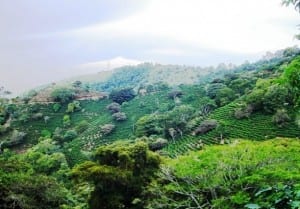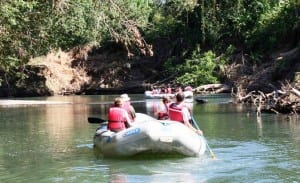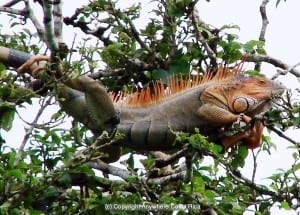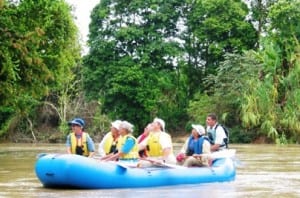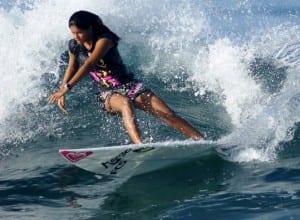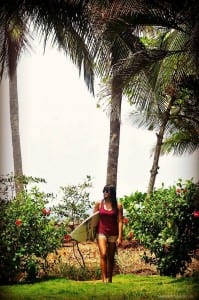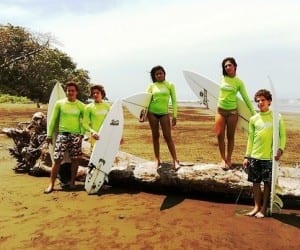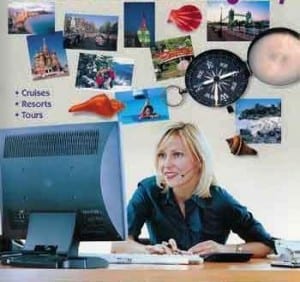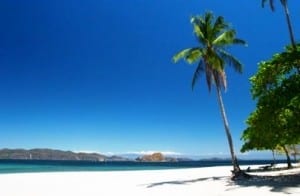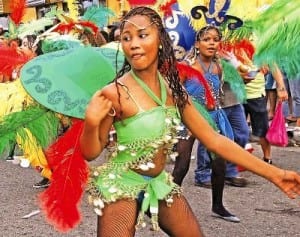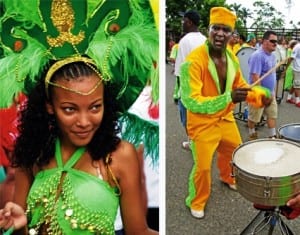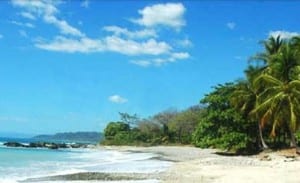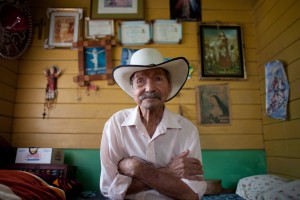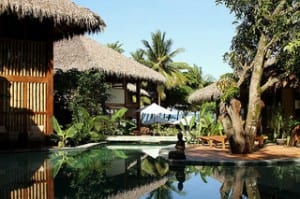If you don’t know how to scuba dive, or don’t have the equipment, snorkeling is just as fun. Besides, most of the colorful sea life is within the first 20 feet of water anyway. Snorkeling or scuba diving in tropical waters is the best. Usually, it’s like swimming in a glass of drinking water, visibility is so clear.

In Costa Rica’s Central Pacific area, just off the coast of the Nicoya Peninsula in the Nicoya Gulf, the quintessential tropical paradise of Tortuga Island is a diver’s dream. The crystal clear turquoise waters surround volcanic rock reef and sandy ocean floor. With very little ocean current around the island, it makes for an ideal place to swim, snorkel and scuba dive.
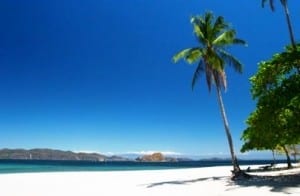 Average water visibility ranges from 30 to 50 feet or more, especially in dry season (mid-December to April).
Warm tropical waters are teeming with giant schools of yellowtails,
spotted eagle rays, stingrays, angel fish, parrot fish, sea horses,
octopus, needlefish, starfish, frog fish and many species of eels.
Snorkeling and diving guides report regularly seeing white tip sharks,
sea turtles, dolphins, and the mammoth gentle whale sharks measuring up
to 35-feet-long!
Average water visibility ranges from 30 to 50 feet or more, especially in dry season (mid-December to April).
Warm tropical waters are teeming with giant schools of yellowtails,
spotted eagle rays, stingrays, angel fish, parrot fish, sea horses,
octopus, needlefish, starfish, frog fish and many species of eels.
Snorkeling and diving guides report regularly seeing white tip sharks,
sea turtles, dolphins, and the mammoth gentle whale sharks measuring up
to 35-feet-long!Famous for its sugary white sand beaches lined with tall swaying coconut palms, Tortuga Island is a little piece of heaven you’ll daydream about forever! Tours to the gulf island journey there from points on the Nicoya Peninsula by scenic boat ride, where you get to watch playful dolphins or jumping manta rays. Tours are a full day and include lunch, cold drinks, snorkeling or scuba diving, and time on the island to explore the beach, hike trails, rent a kayak or play volleyball.
Jump in Costa Rica’s ocean waters nearly anywhere and you can see some fish, but along the southern Nicoya Peninsula, there are special spots where the sea life really seems to gather and you have interesting rock and coral formations. And where there are fish, there are larger predators that hunt them.
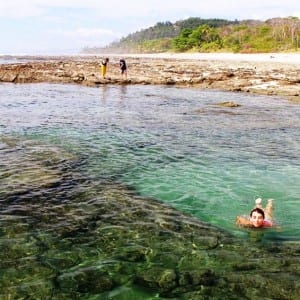
One of the best secrets of the area is the giant tide pool between Hermosa and Santa Teresa beaches. Often over-looked by the surf-oriented travelers, the tide pool is only exposed at low tide, when it makes a larger-than-Olympic-sized shallow sea water swimming pool. The sun-warmed clear water is a little over waist deep and is filled with all kinds of interesting fish and sea creatures that get trapped when the tide goes out. Since the water is shallow and it’s right off the beach, this snorkeling site is perfect for families with kids.
Another beautiful snorkeling site in the area is Playa Los Suecos, also called “Punta Murcielago” (Bat Point) or “The Malpais Secret Beach.” The little beach is tucked right next to the Cabo Blanco Absolute Natural Reserve’s protected marine area, and so is a great site for seeing fish and larger animals like stingrays and sea turtles. It’s called Bat Point because there is a sea cave on the rocky point, accessible only at very low tide that is filled with bats.
Keep in mind when you are snorkeling in Costa Rica, that the country is located very near the equator and the tropical sun reflecting off the water will fry your skin faster than a snapper in a frying pan. Wear a T-shirt or nylon shirt, a hat, and slather on a thick layer of SPF 30 or 50 waterproof sports sunscreen!
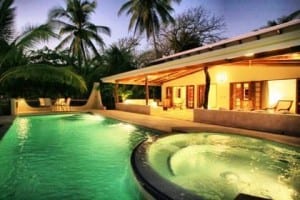
Hotel Tropico Latino on the Nicoya Peninsula’s gorgeous Santa Teresa Beach can arrange all of your snorkeling and scuba diving adventures. The intimate beachfront boutique hotel rests right on four acres of unspoiled white sand at Santa Teresa, nearby to all the best swimming and surfing areas and natural tide pools.
Visit now and you can take advantage of tempting special offers, with discounts from 25% to 15% on rooms during November and December 2012. Treat yourself to a well-deserved break and benefit from these great deals!
 Imagine your own secluded luxury suite right on the beach, relaxing in your private pool and Jacuzzi while watching dazzling sunsets over the Pacific Ocean, then dining al fresco on your private terrace. That’s the Beachfront Suite. Second-story Superior Beachfront Rooms
overlook the water just a few feet away from the sand. They have
modern, comfortable furnishings, artistically-designed private bathrooms
with a bathtub, and a private balcony. You can step right out into the
sand from Hotel Tropico Latino’s Beach Front Rooms.
Comfortable furnishings, open-air private bathrooms and a large wooden
deck are main features of the tropical-themed building. Garden View Bungalows
are surrounded by abundant tropical gardens under the forest canopy.
Each comfortable stand-alone bungalow has a private porch with hammocks
and lounge chairs.
Imagine your own secluded luxury suite right on the beach, relaxing in your private pool and Jacuzzi while watching dazzling sunsets over the Pacific Ocean, then dining al fresco on your private terrace. That’s the Beachfront Suite. Second-story Superior Beachfront Rooms
overlook the water just a few feet away from the sand. They have
modern, comfortable furnishings, artistically-designed private bathrooms
with a bathtub, and a private balcony. You can step right out into the
sand from Hotel Tropico Latino’s Beach Front Rooms.
Comfortable furnishings, open-air private bathrooms and a large wooden
deck are main features of the tropical-themed building. Garden View Bungalows
are surrounded by abundant tropical gardens under the forest canopy.
Each comfortable stand-alone bungalow has a private porch with hammocks
and lounge chairs.
